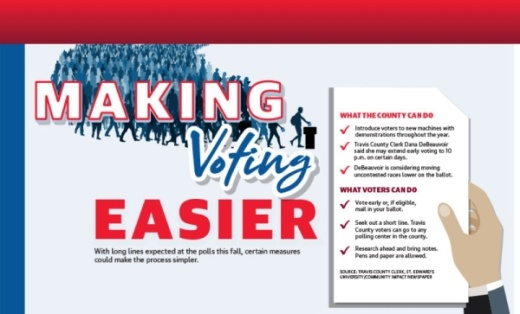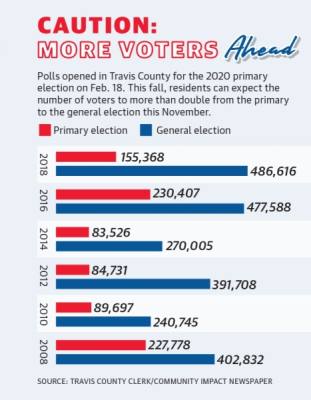Unlike past years, when that November election comes, voters in Texas will no longer have the option to press one button to go straight down the ticket to vote for every candidate from one political party. The Texas Legislature eliminated the straight-party option in 2017 but delayed implementation of the new rule until 2020.
Republicans said the move will benefit Texans by ensuring voters make more informed choices, while Democrats argue the choice amounts to voter suppression because it creates longer wait times, therefore making it more difficult for Texas citizens to vote.
However, there are also implications to the decision that are more practical than they are partisan. Travis County Clerk Dana DeBeauvoir said her office is preparing for longer lines at the polls because voters will take more time to go through the lengthy ballot. Because of that, DeBeauvoir said the clerk’s office is encouraging local voters to make a plan that ensures a smooth experience.
Avoiding the crowds in November
After fall 2019 election final results were delayed until 3:40 a.m., DeBeauvoir said processes would have to change heading into 2020.
Some of those issues have been addressed, DeBeauvoir said. After consultation with the state, the clerk’s office will no longer have to manually count every vote from locations that have more than four “fleeing voters”—or people who check in without casting a ballot. New voting systems introduced in 2019 require voters to make their selections at one machine, then deposit their ballot in another. DeBeauvoir said some voters last year walked off without completing the final step. The clerk’s office will still keep track of all those individuals, but DeBeauvoir said avoiding the manual recount that happened last fall will save time.
The other issue in fall 2019 that slowed results was long lines. She said 17,200 people showed up to vote after 5 p.m. on Election Day in November, and the last vote was not cast until 9:30 p.m.
Although not finalized, DeBeauvoir she is also discussing moving all uncontested races to the bottom of the ballot this fall and extending early voting hours at the county’s four megacenters on certain days of early voting until 10 p.m.
“You don’t have to create a three-hour line at the grocery store. Travis County has lots of places in the field, and there are places to [vote] where you don’t have to be burdened with standing in line that long,” she said.
In addition to the elimination of straight-ticket voting, the introduction of new technology is another challenge. The county’s new voting machines were in use in the fall 2019 elections, but past results indicate many residents will use them for the first time this year. In November 2019, 122,235 county residents cast their ballots, compared with 477,588 votes registered in the 2016 presidential election.
Brian Smith, a political science professor at St. Edward’s University, said taking advantage of the two-week early voting period will be the most important thing voters can do to avoid the longer lines caused by the new ballot system and the recent technology changes.
“For this election in particular, if you can early vote, I would go do it,” Smith said.
Partisan Perspectives
Straight-ticket voting has been available to Texans for decades, but it was not always the way most residents voted: According to a report authored by retired Austin Community College professor Stefan Haag and former Democratic campaign strategist Peck Young, split-ticket voting increased in the 1970s and 1980s in Texas, but as the Republican party rose to power at the end of the 20th century, so, too, did straight-ticket voting.
“Much of the increase in Republican dominance in Texas was fueled by straight-ticket voting, which also increased the percentages of Texas Republicans elected to partisan positions in Texas counties,” the report said.
By 2018, according to another report from Haag, more than two-thirds of voters in the most populous 48 counties in Texas took the straight-ticket option.
“As the attitudes of people harden across party labels, and as you get brand loyalty increasing ... then what you’re going to have is more and more people are just looking for their brand,” Young said.
Republican state leaders argued eliminating the straight-ticket option would make voters more informed to each of their choices.
“A vote is something that’s so precious to what it means to be an American and what it means to be a Texan. It shouldn’t be something we do flippantly without thinking about it,” said Brian Ruddle, executive director of the Travis County Republican Party.
But according to Smith, decisions such as this one almost always have a political motivation. Even though Republicans rode the wave of straight-ticket voting to political power, and some still benefited in certain areas of the state, he said state party leadership saw elimination as a political win.
“You never change election rules for good; you change election rules for gain. Sometimes it’s couched in good, but there’s always an upside,” Smith said.
The report released by Haag and Young asserts that down-ballot Democrats will be hurt most by the elimination of straight-ticket voting because the practice was more common among racial and ethnic minorities in cities—voters who will likely no longer take the time to wait in line and vote for individual candidates in state house, judicial or county races.
“It’s malicious. It’s more voter suppression,” Young said.
Retiring Travis County Commissioner Gerald Daugherty said the elimination of straight-ticket voting will help candidates like him—a Republican in a heavily Democratic county.
Daugherty attributes election wins in 2012 and 2016 largely to one issue he made his signature campaign promise—the SW 45 toll road—which helped him win over both Democrats and independents. When the 2016 and 2012 results were officially tabulated, Daugherty’s margin of victory in each was less than 3.5 percentage points.
“There were some Democrats that said, ‘I would never vote for a Republican. You can’t expect me to give you my vote. But what I’m going to do is not vote for the Democrat,’” Daugherty said.
While political perspectives differ, DeBeauvoir said one message she wants to come through is that while residents may have to adjust their fall election plans a bit, the clerk still wants to encourage everyone to come out to the polls.
“We don’t want to tell anybody, ‘Don’t go vote.’ That’s the last thing we want to say,” DeBeauvoir said. “We love you. We want you to vote.”







